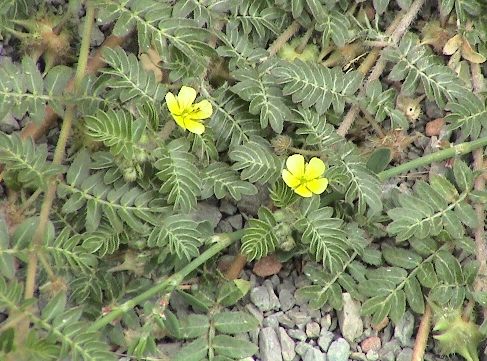Puncturevine (Tribulus terrestris)
Identification
Puncturevine is a non-native annual plant introduced from Europe. It reproduces from seed only. It is a mat forming, prostrate plant that has stems 1-6 feet long. Leaves are opposite, pinnately compound, 1-2 inches long with 4-8 pairs of leaflets. Flowers are yellow, 1/8 to 1/2 inch broad with five petals. The seed is a hard spiny bur that has three spines to each seed capsule. Puncturevine grows in pastures, cultivated fields, roadsides, and waste places.
Mechanical Control
Since puncturevine is a summer annual, keeping it from going to seed is imperative. It emerges throughout the summer in Colorado, flowering July-September. Puncturevine bas a simple taproot and can be controlled by hand pulling the plant, keeping the root intact. Hand pulling should be carried out up through early flower stage, If pulling occurs after flowering, make sure the seeds are not dislodged and that the plants are bagged and thrown away.
Chemical Control
Puncturevine can be controlled chemically by preemergent or postemergent herbicide applications. Location of the infestation and the management objectives will determine the herbicides to be used. In turf and unimproved turf sites. Certain preemergent (prior to green-up of vegetation) fertilizer/crabgrass preventer products will control puncturevine as the seeds germinate. Products that have pendimethalin or trifluralin as the herbicidal active ingredient are very effective on puncture vine. The first application to the lawn should be made by early April. Read the label for complete application instructions. After puncturevine has emerged it is important to switch to a postemergent broadleaf herbicide that has one or more of the following herbicides; 2,4-D, 2,4-DP, Dicamba, MCPA, or MCPP. For turf applications there are numerous postemergent broadleaf products that have one or more ofthcse compounds in them.
In ornamental sites, rock gardens, end other non-crop sites there are products that can be used without the fertilizer that have the various herbicid2J active ingredients as stated above. Products that can be used include:
Pendulum 3.3 EC or WDG
Treflan 5G
Surflan AS
When choosing a herbicide for use on your property, it is imperative that you read the label first and pick a product that is labeled for your intended use and site.




